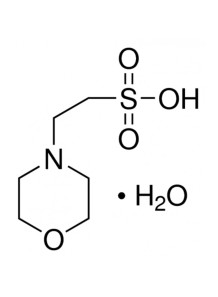MES.H2O, 2-(N-morpholino)ethanesulfonic acid monohydrate
- Product Code: 35437
MES.H2O, or 2-(N-morpholino)ethanesulfonic acid monohydrate, is a commonly used buffer compound in biochemical and molecular biology applications.
- -
- -
- -
- -
- -
- -
- -
- -
- -
- -
- -
- -
- -
- -
- -
- -
- -
- -
| Test Name | Specification |
|---|---|
| Appearance | White crystalline powder |
| Assay (%) | 99 Min |
| Solubility (0.1M aq.) | Clear, colorless solution |
| Water Content (%) | 7.9-8.9 |
| pH | 2.5-4.0 |
| Ultraviolet Absorbance, 260nm | 0.04 Max |
| Ultraviolet Absorbance, 280nm | 0.02 Max |
MES.H2O, or 2-(N-morpholino)ethanesulfonic acid monohydrate, is a commonly used buffer compound in biochemical and molecular biology applications.
1. Chemical Structure and Properties:
- MES.H2O is the monohydrate form of the buffer compound MES (2-(N-morpholino)ethanesulfonic acid).
- It is a white, crystalline powder that is highly soluble in water and other polar solvents.
- MES.H2O has a pKa value of around 6.1, making it useful for maintaining a slightly acidic pH range.
2. Applications:
- Protein Purification: MES.H2O is often used as a buffer component in various protein purification techniques, such as ion-exchange chromatography and affinity chromatography.
- Enzyme Assays: MES.H2O buffers can help maintain the optimal pH environment for enzymatic reactions and activity measurements.
- Nucleic Acid Manipulation: MES.H2O can be used as a buffer in applications involving DNA and RNA, such as gel electrophoresis and enzymatic reactions.
- Cell Culture: MES.H2O may be included in cell culture media to help maintain the desired pH range for cell growth and metabolism.
3. Advantages:
- pH Buffering Range: MES.H2O is effective in maintaining a pH range of approximately 5.5-7.0, making it suitable for applications that require a slightly acidic to neutral environment.
- Compatibility: MES.H2O is generally considered a biocompatible buffer and is widely used in biological and biochemical applications.
- Solubility: MES.H2O has good solubility in water and other polar solvents, allowing for easy preparation of buffer solutions.
4. Considerations:
- Temperature Dependence: The pH of MES.H2O buffer solutions can be affected by temperature, so the pH should be carefully monitored and adjusted as needed.
- Potential Interactions: Like any buffer, MES.H2O may interact with certain compounds or materials, so its compatibility should be evaluated for specific applications.
Overall, MES.H2O is a widely used buffer compound in various biochemical and molecular biology applications, particularly in the areas of protein purification, enzyme assays, and nucleic acid manipulation.
Be the first to review this product :-)
Recommend Lab-Service
| Lab Service | Price |
|---|
MES.H2O, or 2-(N-morpholino)ethanesulfonic acid monohydrate, is a commonly used buffer compound in biochemical and molecular biology applications.
MES.H2O, or 2-(N-morpholino)ethanesulfonic acid monohydrate, is a commonly used buffer compound in biochemical and molecular biology applications.
1. Chemical Structure and Properties:
- MES.H2O is the monohydrate form of the buffer compound MES (2-(N-morpholino)ethanesulfonic acid).
- It is a white, crystalline powder that is highly soluble in water and other polar solvents.
- MES.H2O has a pKa value of around 6.1, making it useful for maintaining a slightly acidic pH range.
2. Applications:
- Protein Purification: MES.H2O is often used as a buffer component in various protein purification techniques, such as ion-exchange chromatography and affinity chromatography.
- Enzyme Assays: MES.H2O buffers can help maintain the optimal pH environment for enzymatic reactions and activity measurements.
- Nucleic Acid Manipulation: MES.H2O can be used as a buffer in applications involving DNA and RNA, such as gel electrophoresis and enzymatic reactions.
- Cell Culture: MES.H2O may be included in cell culture media to help maintain the desired pH range for cell growth and metabolism.
3. Advantages:
- pH Buffering Range: MES.H2O is effective in maintaining a pH range of approximately 5.5-7.0, making it suitable for applications that require a slightly acidic to neutral environment.
- Compatibility: MES.H2O is generally considered a biocompatible buffer and is widely used in biological and biochemical applications.
- Solubility: MES.H2O has good solubility in water and other polar solvents, allowing for easy preparation of buffer solutions.
4. Considerations:
- Temperature Dependence: The pH of MES.H2O buffer solutions can be affected by temperature, so the pH should be carefully monitored and adjusted as needed.
- Potential Interactions: Like any buffer, MES.H2O may interact with certain compounds or materials, so its compatibility should be evaluated for specific applications.
Overall, MES.H2O is a widely used buffer compound in various biochemical and molecular biology applications, particularly in the areas of protein purification, enzyme assays, and nucleic acid manipulation.
| Mechanism | - |
| Appearance | - |
| Longevity | - |
| Strength | - |
| Storage | - |
| Shelf Life | - |
| Allergen(s) | - |
| Dosage (Range) | - |
| Recommended Dosage | - |
| Dosage (Per Day) | - |
| Recommended Dosage (Per Day) | - |
| Mix Method | - |
| Heat Resistance | - |
| Stable in pH range | - |
| Solubility | - |
| Product Types | - |
| INCI | - |
Cart
No products



